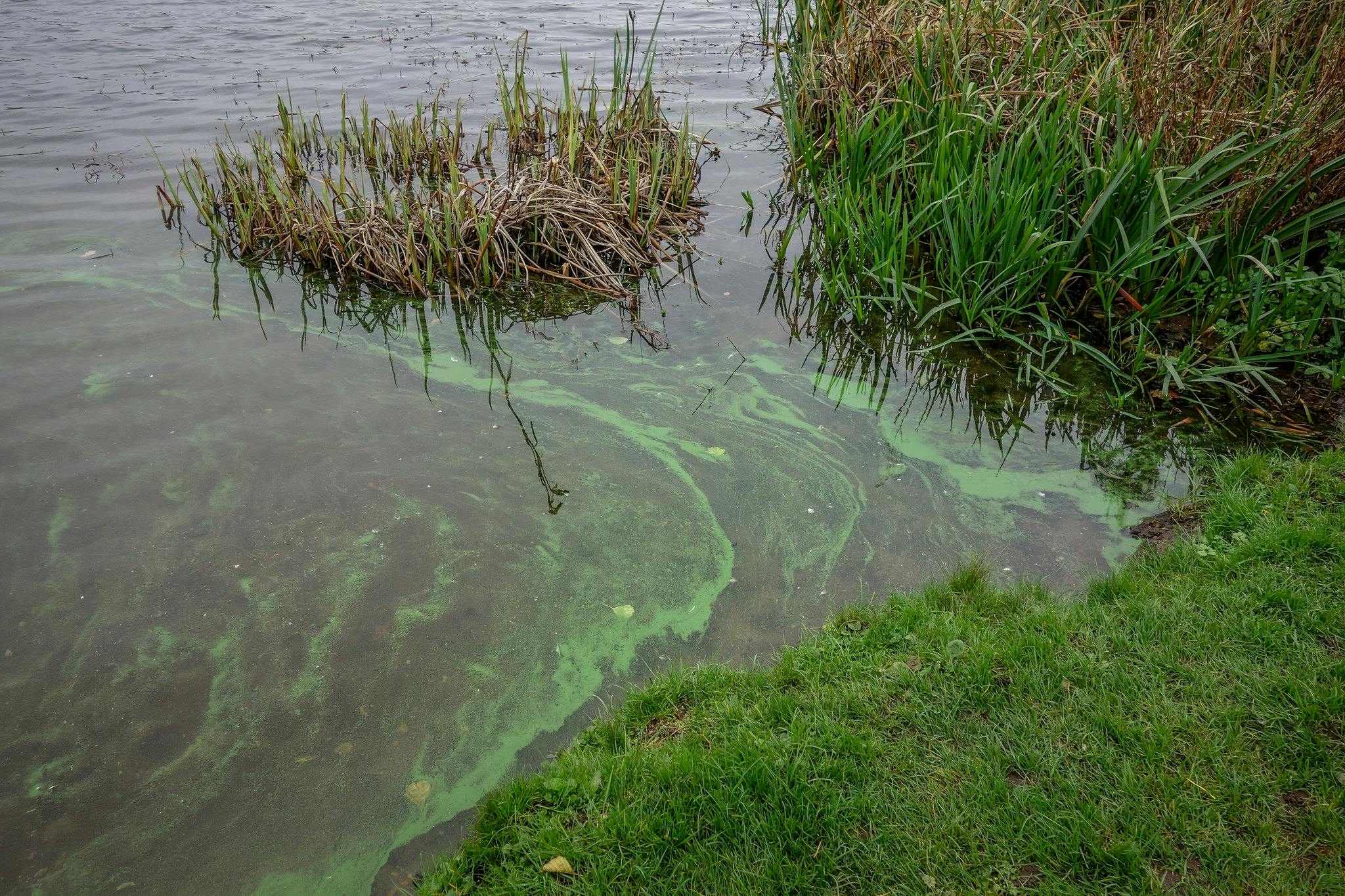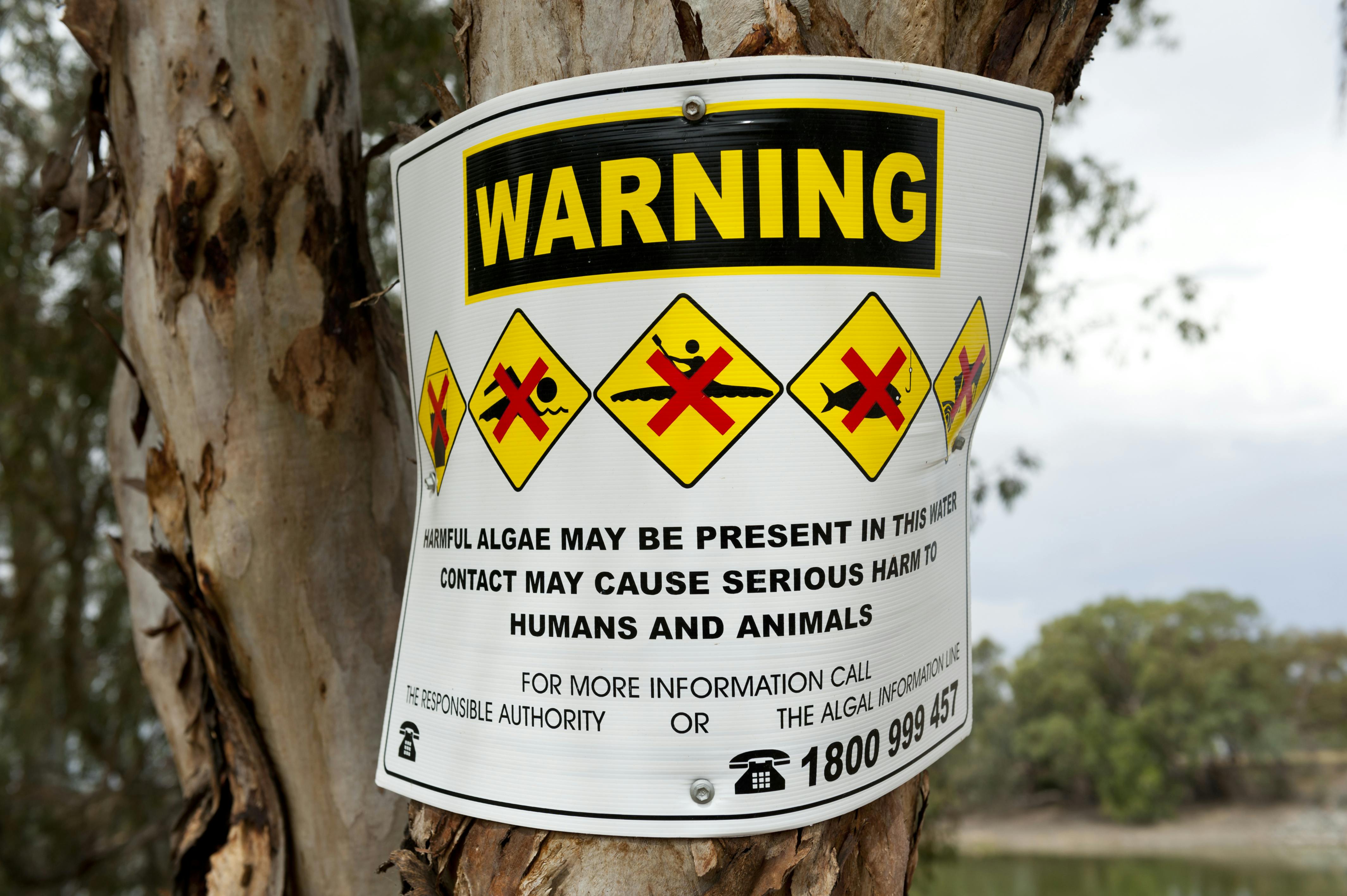The shortest answer is yes. Blue-green algae blooms can make your dog extremely sick, and they can die from coming into contact with water contaminated by blue-green algae.
Blue-green algae is a kind of bacteria called cyanobacteria. Blue-green algae blooms can occur in fresh or saltwater when blue-green algae reproduces. This bacteria can even reproduce in the standing water in your backyard. Blue-green algae often coats the water with brown, blue, or neon green scum, and gives off a pungent smell.
Blooms are most common in late summer and early fall, but they can happen earlier in the summer during hot weather and certain conditions.
A fun swim in a pond can quickly become fatal for your dog if there is blue-green algae in the water.
Learn how to keep yourself safe from algae:
5 ways to protect yourself from blue-green algae
What you need to know about algae this summer
What are cyanobacteria and cyanotoxins?
Not all cyanobacteria will harm your pooch, but many species (about 50-70%) have adverse health effects on both dogs and people.
Under certain conditions, some species of cyanobacteria produce toxins. These toxins are called cyanotoxins, and they are contained within cyanobacterial cells. Cyanotoxins, which are present in about 30-50% of blooms, are very dangerous. Furthermore, cyanobacteria in certain quantities are harmful even when they’re not toxic.
Keep in mind that not all blue-green algae is toxic, but all of it is dangerous.
It’s not possible to tell if the algae is toxic just by looking at it, but the presence of blue-green algae blooms does tell us that cyanotoxins may be in the water.

For humans, contact with blue-green algae can cause skin irritations and allergic reactions. Cyanotoxins can cause headaches, fever, vomiting, diarrhea, and abdominal pain. Ingesting water contaminated by toxins can be very serious, or in some cases fatal.
For dogs, blue-green algae is even more dangerous. Dogs who love swimming are especially at risk of being exposed to this toxic substance. Hunting dogs are also at high risk because of how much time they spend outdoors.
How can you recognize blue-green algae?
Blue-green algae usually gives off a blue or green shimmer on the water, though it may be brown or red as well. It may look like there is paint on the surface of the water, or the water may appear slimy, scummy, or foamy.
Not all blue-green algae blooms are visible on the water’s surface. Murky or cloudy water may indicate a bloom below the surface. If you are unable to see your feet in knee deep water, the water may be contaminated.

Keep your eyes peeled and keep your nose alert. Blue-green algae may give off a strong, swampy smell similar to that of decomposing plants. If there is a foul odour near the water, it’s best not to risk letting your pup swim.
How can blue-green algae enter your dog’s system?
The toxins in blue-green algae can enter your dog’s system in a number of ways. Swimming in, swallowing, drinking, or licking contaminated water off their own fur lead to blue-green algae poisoning.
Dogs can get sick from eating contaminated fish or other seafood and wildlife, too. It’s also possible for your dog to get sick through airborne toxins through their skin, eyes, or mouth.
How can you prevent blue-green algae from entering your dog’s system?
Preventing your furry friend from coming into contact with blue-green algae is the easiest way to keep them safe.
There is no antidote for blue-green algae toxins and dogs who ingest it have a poor prognosis. For dogs who are fortunate enough to survive, recovery may take weeks or months and they are often left with liver damage or other chronic issues.
How to keep your dog safe from blue-green algae:
- Avoid letting your dog drink from stagnant bodies of water like ponds or lakes (especially if there are any signs blue-green algae present).
- Rinse your dog with clean water after a swim so that your dog will not ingest any contaminants trying to clean themselves.
- Be on the lookout for signs or warnings posted around the body of water, or check online to see if blue-green algae blooms have been reported in the area.
- Be on the lookout for other signs that the water is contaminated. If you see dead fish or birds around the water, do not let your dog near it.
How can you tell if your dog has been exposed to blue-green algae and what should you do?
If your dog has been exposed to blue-green algae, you will likely begin seeing symptoms within the first few minutes, though they can also take days to appear. Small issues like skin and eye irritation can rapidly develop into much more pronounced symptoms like vomiting and diarrhea.
Symptoms of blue-green algae toxicity in dogs:
- Panting or laboured breathing
- Excessive drooling or tearing
- Lethargy, weakness, or disorientation
- Difficulty walking
- Jaundice, blue discolouration of coat, skin, and mucous membranes
- Vomiting, diarrhea, or bloody, tarry, or black stool
- Liver or respiratory failure
- Seizures, convulsions, muscle tremors, or muscle rigidity
- Paralysis
- Coma
- Death
The symptom onset of blue-green algae toxicity can happen quite fast, so it’s crucial to get your dog medical assistance as soon as you can. Waiting a few hours or a day for emergency care could be fatal. Prompt and aggressive treatment by a professional is necessary.
If you suspect your dog has come in contact with blue-green algae, immediately wash your dog off with clean water to remove as much of the bacteria as possible. Wear gloves to protect your own skin. Get your dog to the vet as soon as you can. Go to a 24 hour emergency clinic if necessary.
For dogs, water is water. Water that looks off-putting to you may look inviting to your dog.
It’s our responsibility to ensure that our dogs do not enter any water that looks like it may contain blue-green algae. Be vigilant near beaches, lakes, ponds, and hiking trails, and if your dog cannot be trusted to obey you, keep your dog on a leash until you’ve inspected the water.

